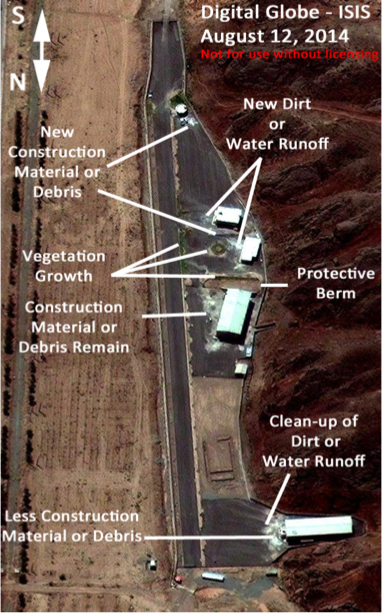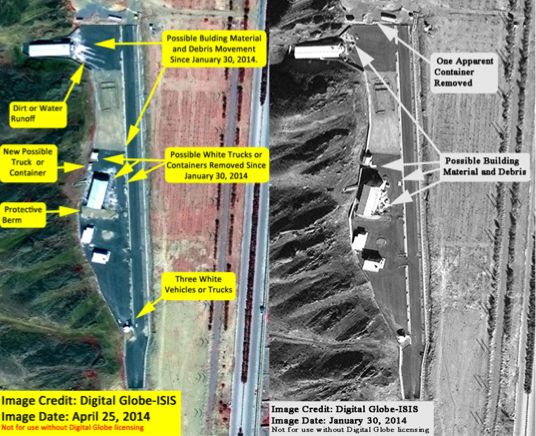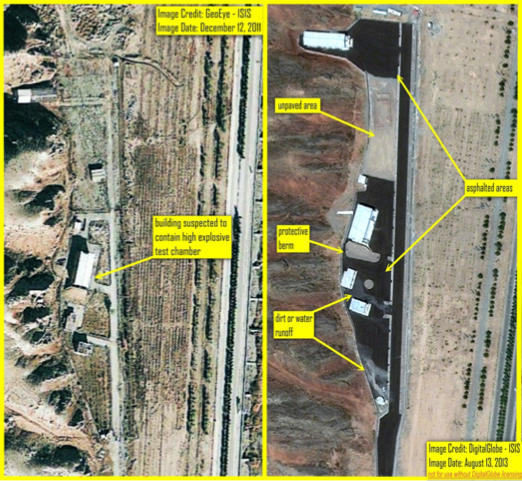Reports
Update on Parchin: A Necessary Piece of a Comprehensive Nuclear Deal
by David Albright, Serena Kelleher-Vergantini, Andrea Stricker, and Daniel Schnur
September 3, 2014
As of late August 2014, the Islamic Republic of Iran had refused to allow the International Atomic Energy Agency (IAEA) to visit the Parchin site, where high explosive activities related to nuclear weapons development are alleged to have taken place. Addressing the IAEA’s concerns about activities at Parchin and other allegations about the military dimensions of Iran’s nuclear program is fundamental to Iran satisfying its safeguards obligations and a prerequisite to achieving a long-term agreement under the Joint Plan of Action between the P5+1 and Iran. Although much of the debate rightly focuses on Tehran’s uranium enrichment and plutonium production capabilities, a long term agreement that sidesteps the military nuclear issues would risk being unverifiable and would undermine the IAEA’s ability to determine that all nuclear material in Iran is used in peaceful activities.
Recently, Iran’s Minister of Defense Brigadier General Hossein Dehghan stated that the IAEA would not be granted access to the Parchin complex.1 This statement from Iran’s senior military official appears to reflect the official views of Iran’s military, likely including its Revolutionary Guard (IRGC), and may be aimed at establishing a precedent that the IAEA cannot visit military sites. However, the IAEA and the P5+1 have rejected the notion that military sites are off-limits to the IAEA when it seeks to ensure that a state is in compliance with its obligations under a comprehensive safeguards agreement. Parchin represents a key outstanding issue to the IAEA in resolving its concerns about Iran’s past and possibly on-going nuclear weapons activities.
To resolve the Parchin issue, Iran will need to allow the IAEA to visit the site, provide information and access to officials linked to activities at the site, and possibly permit visits to other sites. If Iran does not provide far more cooperation on this issue, it risks not achieving a final deal with the P5+1.
Background and Imagery Analysis
Iran is alleged to have conducted work related to nuclear weapons development at a site at the Parchin military complex. The IAEA first asked to visit this site on the northern end of the complex after evidence suggested that at least one building was the location of high explosive tests related to the development of nuclear weapons.2 However, Iran denied access to the IAEA, undertook substantial reconstruction and site modifications, and, despite repeated requests by the IAEA and its Board of Governors to stop such activities and grant access, sanitized, demolished portions of, and reconstructed the site in an apparent effort to hide past activities and undermine the IAEA’s ability to conduct effective verification.
Recent Digital Globe satellite imagery dated August 12, 2014 shows that some activity continues at the Parchin site. As figure 1 shows, new construction material or debris, as well as new dirt or water runoff, appear in front of three buildings in the southern part of the site (top of figure 1). Also, light vegetation appears to be growing at the center of the site, including on the protective berm, and the construction material or debris previously identified in front of the suspected test building remains. Finally, the dirt or water runoff and some of the possible construction material that appeared in previous imagery is no longer present in front of the large building in the northern part of the site (bottom of figure 1).
A May 2014 ISIS Imagery Brief showed several signs of external activity at the site. ISIS noted that possible building material and debris appeared in front of two main buildings at the site (figure 2). Two trucks or containers had been removed from the area surrounding the suspected high explosives test building, while a larger object, possibly a truck or large container, appeared slightly north of it. Dirt or water runoff was visible in front of the northern building and three vehicles were clearly visible at the south entrance.
Previously, a February 2014 ISIS Imagery Brief confirmed IAEA reporting of possible building material and debris appearing at the site (figure 2)3. All of this activity followed a period of lull at the site (second half of 2013) in which commercial satellite imagery showed no significant visible alterations (figure 3).
The extent of the modification of the site can be appreciated in figure 4. A 2011 image, taken before the IAEA’s request to visit, is juxtaposed to an August 2013 image, which shows extensive site modifications.
Impact on Verification
Effective verification is one of the most important issues at stake in the negotiations for a comprehensive deal with Iran. As noted in a previous ISIS Report entitled “The Six’s Guiding Principles in Negotiating with Iran,” one of the IAEA’s tasks is to establish confidence in the absence of undeclared nuclear materials or facilities, including providing assurances that Iran’s nuclear program is strictly dedicated to peaceful purposes.4 Resolving the Parchin issue is central to the IAEA achieving this goal. Moreover, a failure of the IAEA to gain access to Parchin could create a precedent that would undermine the verifiability of any long-term deal reached by the P5+1 and Iran.
One of Iran’s most serious verification shortcomings has been its unwillingness to address the IAEA’s concerns about the past and possibly on-going military dimensions of its nuclear program, both in terms of providing necessary information and access to sites. Iran’s resistance is reinforced by a statement issued by Iran’s Minister of Defense Dehghan during a press conference held Friday, August 22, 2014. The Minster stated that “the IAEA has inspected Parchin several times and it has performed its sampling and has not discovered anything illegal. Unfortunately, the agency gets its information from enemies and hypocrites since this information has never been accurate. Because Iran is pursuing transparency, therefore no reason for further access to Parchin exists, because nothing has occurred after the last inspection.”5 However, the Minister’s statement is misleading.
In fact, when the IAEA visited sites in Parchin in 2005, it was only able to access a subset of sites it wanted to visit and was not able to determine if the Parchin complex was indeed uninvolved in military nuclear activities. Moreover, since that visit, the IAEA has obtained additional information from several member states that a site not visited in 2005 was the location of high explosive work related to nuclear weapons development prior to 2004. The IAEA is acting within its rights under Iran’s comprehensive safeguards agreement to seek access to the Parchin site, a right confirmed numerous times by the IAEA’s Board of Governors and the UN Security Council. Iran has no legal right to deny the IAEA’s visit and by doing so the Iranian regime reduces the chances of resolving the nuclear issue.
Allowing a visit is a necessary step for the IAEA’s determination that Iran is in compliance with its safeguards agreement. But because of the extent of the site’s modification, a visit is unlikely to be enough to resolve this outstanding issue. Iran will likely need to also provide information and access to officials linked to activities at the site, and possibly permit visits to other related military sites.
If Iran refuses to resolve this issue, it will only make it much harder for the IAEA to find Iran in compliance with its safeguards agreement. Its actions also threaten the achievement of a comprehensive long-term agreement with the P5+1. If Iran can prevent the IAEA from inspecting military sites, such as Parchin, where work is alleged to have taken place on developing nuclear weapons, it could also use that precedent to deny the IAEA access to other military sites, some of which Iran could use later to hide a covert centrifuge or nuclear weaponization plant. Limiting nuclear capabilities at known sites does not make sense if at the same time the deal makes it easier for Iran to make weapon-grade uranium at secret sites. The deal must focus on both potential pathways. Calls for the IAEA not to press to visit Parchin or other military sites or to ignore past military nuclear related efforts are therefore at best naïve and reflecting of a poor understanding of adequate verification and arms control policy.
Without addressing allegations of Iran’s work on nuclear weapons at sites such as Parchin, the IAEA and the P5+1 cannot construct an adequate verification regime capable of detecting clandestine nuclear facilities and activities. The IAEA does not understand how much Iran knows about making nuclear weapons. When did Iran seek nuclear weapons, how far did it get, what types did it pursue, and how and where did it do this work? How long would it take Iran to weaponize fissile material? Was this weapons capability just put on the shelf, waiting to be quickly restarted? Who worked on these projects? The IAEA needs a good baseline of Iran’s military nuclear activities in order to design a verification regime. Moreover, to develop confidence in the absence of weaponization activities, the IAEA will need to periodically inspect past weaponization sites and interview key individuals for years to come. Without more information, it does not know where to go and who to speak to, let alone whether such activity is continuing in a covert manner. Fundamental questions at the core of this decade long controversy would remain unanswered.
For there to be a deal, Iran must provide the IAEA with a concrete demonstration that it has given up its nuclear weapons program, such as acknowledging having had a nuclear weapons program, or some sort of “coming clean,” and pledging full cooperation with the IAEA in its ongoing investigation. One of these initial concrete steps should be resolving the Parchin issue, including an IAEA visit to the site. If Iran refuses to make a concrete demonstration, it should not receive major sanctions relief.



Figure 3. Digital Globe imagery shows the status of the alleged high explosive test site at the Parchin military complex in August and November 2013.

Figure 4. Geo Eye/Digital Globe imagery shows the status of the alleged high explosive test site at the Parchin military complex in December 2011 and August 2013.
1 “IAEA Inspection on Parchin Base Unnecessary: Iranian Official,” Xinhua News Agency, August 23, 2014, http://www.globalpost.com/dispatch/news/xinhua-news-agency/140823/iaea-inspection-parchin-base-unnecessary-iranian-official. 2 The IAEA also had evidence that a former Soviet nuclear weapons expert had aided in the development of testing equipment used inside the building. See David Albright and Robert Avagyan, “Revisiting Danilenko and the Explosive Chamber at Parchin: A Review Based on Open Sources,” ISIS Report, September 17, 2012, http://isis-online.org/isis-reports/detail/revisiting-danilenko-and-the-explosive-chamber-at-parchin-a-review-based-on/8, and Mark Gorwitz, “Revisiting Vyacheslav Danilenko: His Origins in the Soviet Nuclear Weapons Complex,” ISIS Report, September 17, 2012, http://isis-online.org/uploads/isis-reports/documents/Gorwitz_Revisiting_Vyacheslav_Danilenko_17Sept2012.pdf. 3 Director General, International Atomic Energy Agency, Implementation of the NPT Safeguards Agreement in the Islamic Republic of Iran, GOV/2014/10, February 20, 2014, http://isis-online.org/uploads/isis-reports/documents/iaea-iranreport-02202014.pdf. 4 David Albright, Olli Heinonen, and Andrea Stricker, “The Six’s” Guiding Principles in Negotiating with Iran,” ISIS Report, July 22, 2014. http://www.isis-online.org/uploads/isis-reports/documents/Principles_and_Compromises-_july_22_2014-final1.pdf 5 “IAEA Inspection on Parchin Base Unnecessary: Iranian Official,” op. cit.

 twitter
twitter